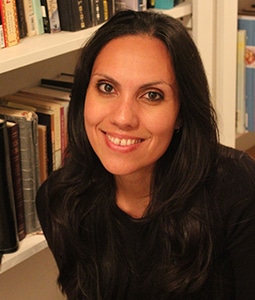In October 2021, Professor Monica Reyes of the Writing, Rhetoric, and Discourse program was awarded a fellowship to further her Shelter Rhetorics manuscript. The grant was awarded through the American Association of University Women. Her manuscript is a timely piece that looks to engage a dialogue around the rhetorics of displacement and asylum.
This work is vital to Dr. Reyes’ scholarship as she helps students navigate through these kinds of rhetorics in her classes. In the last three years, she has taught two separate, service-learning courses that highlight “countering the predominant victim narrative we often hear about asylum experience.” For example, in WRD 511: Rhetorics of Displacement, which Dr. Reyes taught last spring, her students partnered with clients from a South Texas shelter who wanted to share their own stories to counteract the stereotypes of the asylum experience. Reyes said her students interviewed clients who shared stories of cooking passions or their children. One student created artwork to highlight their client’s story. The inspiration for the project was inspired by Another Way Home.
What is your Shelter Rhetorics manuscript about?
Shelter Rhetorics will focus on a study I conducted at an emergency homeless shelter for displaced people on the
U.S.- Mexico border. I investigated how people who seek asylum and those who work with them at the shelter navigate the rhetorical pressures of having to write compelling asylum narratives.
The project was inspired by the fact that a person is eligible to apply for asylum in the U.S. if they are able to effectively persuade the government— in writing— about the circumstances surrounding their escape from persecution in their home country. These narratives are vital as they open opportunities for work, education, and a pathway to resettlement in the U.S. However, composing these stories is challenging because of cultural, linguistic, and economic barriers which disproportionately affect women and families. For example, recent policy revisions in the U.S. deem persecution based on gender-based violence, like sex trafficking, outside the scope of asylum.
Through the shelter community’s own interviews, drawings, and photos, this book will demonstrate how liminal sites, like this shelter, provide opportunities for displaced communities to employ what I term
“shelter rhetorics”, distinct shared rhetorical practices of daily life—like silence and routine—that both safeguard vulnerabilities and enact agency for individuals within precarious spaces. By practicing shelter rhetorics,
the shelter encourages clients to tell their unique stories in ways that help them move forward as well as critique reductive dominant discourses about what it means to be an “asylum seeker”. To complete this IRB-approved project, I interviewed 17 people at the shelter, including clients from a variety of geographical regions, as well as staff and volunteers.
When did counterstories become a focus for your scholarship?
First, I don’t necessarily define counterstory the exact same way that Aja Martinez does; specifically, I don’t create a composite story based on stories I hear. I’ve met such a variety of people who have traveled into the U.S., that I wouldn’t be able to paint a composite story in the same way that her research does. Instead, I share individual stories I hear to help people consider the humanity behind the media stories that often bombard our newsfeeds.
After I had spent a few months volunteering with people seeking asylum, I realized how stories are powerful tools to educate communities about why and how people cross borders. However, stories often show one side of [the] asylum experience that can perpetuate the idea that people seeking asylum are helpless. This perspective can make people seeking asylum seem like burdens when they are actually an asset to our country and communities.
Is the community-at-large becoming more welcoming to counterstories than when you first began this kind of work?
This is an interesting question, and I don’t think I have an answer. I certainly hope people are more welcome to listen to diverse stories! I do know that people are interested in immigration and asylum policies, but the issue is divisive, and listening and telling familiar stories (like one that focuses on large crowds, border policing, victimization, etc.) can keep people stuck in certain mindsets or think about issues in a reductive way.
